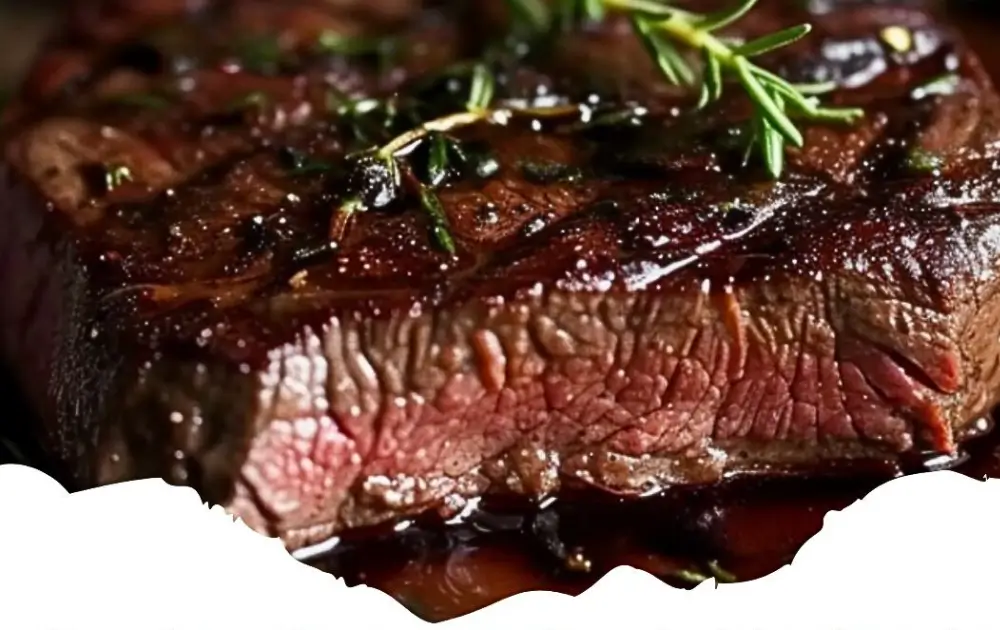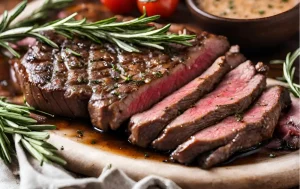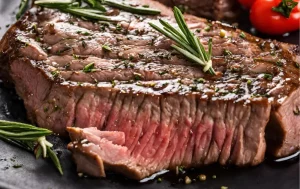Gordon Ramsay, a name synonymous with culinary excellence, shares his secrets to the perfect steak marinade. This guide will walk you through the steps to elevate your steak from good to unforgettable, infusing it with flavors that tantalize the palate.
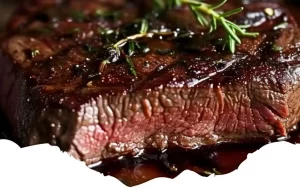
Ingredients and Preparation
Ramsay emphasizes the importance of quality ingredients for the marinade. You’ll need:
- Olive oil, for its rich texture and ability to carry flavors into the meat.
- Soy sauce, adding a depth of umami and saltiness.
- Freshly squeezed lemon juice, for a hint of acidity that tenderizes the steak.
- Worcestershire sauce to introduce a complex, tangy profile.
- Garlic cloves, minced, because no marinade should ever skimp on garlic.
- Fresh rosemary and thyme, finely chopped, will infuse the meat with aromatic herbal notes.
- Freshly ground black pepper and kosher salt, to taste.
Marinating the Steak
Ramsay advises on a few key steps to ensure the marinade works its magic:
- Mix the Ingredients: In a bowl, whisk together olive oil, soy sauce, lemon juice, Worcestershire sauce, minced garlic, chopped rosemary, thyme, salt, and pepper. Ensure the mixture is well combined.
- Prepare the Steak: If you haven’t already, take your steak out of the refrigerator and let it come to room temperature. This ensures even cooking.
- Marinate: Place the steak in a shallow dish or a resealable plastic bag. Pour the marinade over the steak, making sure it’s completely covered. For an even more flavorful experience, gently massage the marinade into the meat.
- Rest: Ramsay stresses the importance of patience. Let the steak marinate in the refrigerator for at least 2 hours, or for optimal flavor, overnight. The longer it marinates, the more pronounced the flavors.
- Ready to Cook: Before cooking, remove the steak from the refrigerator and let it sit for about 20 minutes to reach room temperature. This step is crucial for achieving a perfectly cooked steak.
Cooking Your Steak
With the steak marinated and ready, Ramsay offers guidance for cooking:
- Heat a pan over high heat until it’s smoking hot.
- Add a small amount of oil, then place your steak in the pan.
- Cook to your preferred doneness, flipping the steak only once to ensure a succulent crust.
- Let the steak rest for as long as you’ve cooked it before slicing. This allows the juices to redistribute, ensuring every bite is as delicious as the last.
Gordon Ramsay’s Tips
Throughout the process, Ramsay shares invaluable tips:
- Always choose a high-quality steak. The better the quality, the better the result.
- Don’t skip the resting phase after cooking. It’s as crucial as the marinating step.
- Experiment with the herbs based on your preference, but always use fresh over dried for the best flavor.
By following Gordon Ramsay’s guide to the ultimate steak marinade, you’re not just making a meal; you’re crafting an experience that delights the senses and brings culinary artistry to your table.
Searing to Perfection
Ramsay emphasizes the art of searing the steak to lock in flavors and achieve a crust that’s rich and caramelized. Here’s how he recommends doing it:
- Preheat the Pan: Ensure your pan is hot enough before adding the steak. A cast-iron skillet is ideal for this purpose.
- No Crowding: Cook one steak at a time to avoid overcrowding the pan, which can lead to steaming instead of searing.
- The Sear: Place the steak in the pan and hear that satisfying sizzle. Resist the urge to move it around. Let it sear undisturbed for a few minutes until it develops a crusty, golden exterior.
- Flip Once: Using tongs, carefully flip the steak to sear the other side. Press down gently to ensure even contact with the pan.
Mastering Doneness
Achieving the perfect level of doneness is crucial for the ultimate steak experience. Ramsay provides a simple method to gauge this:
- Use a Meat Thermometer: For precise cooking, insert a meat thermometer into the thickest part of the steak. Here are the temperatures Ramsay suggests for each level of doneness: Rare (120–130°F), Medium Rare (130–135°F), Medium (135–145°F), Medium Well (145–155°F), and Well Done (155°F and above).
- The Finger Test: For those without a thermometer, Ramsay recommends the finger test. Press the base of your thumb for comparison; the firmer the steak feels, the more done it is.
Resting Is Key
After cooking, resting the steak is not just recommended; it’s essential. Ramsay explains why:
- Transfer to a Board: Remove the steak from the pan and place it on a cutting board.
- Loosely Cover: Tent the steak with foil to keep it warm without causing it to sweat.
- Rest: Allow the steak to rest for at least half the time it was cooked. This process helps the fibers relax and reabsorb the juices, making the steak more tender and flavorful.
Serving Suggestions
To complement the rich flavors of the marinated and perfectly cooked steak, Ramsay offers a few serving suggestions:
- Simple Sides: Serve with simple sides that don’t overshadow the steak’s flavor. Grilled vegetables, a light salad, or mashed potatoes work well.
- Sauce Options: While the steak is flavorful enough on its own, a dollop of herb butter or a drizzle of balsamic reduction can add an extra dimension.
- Presentation: Slice the steak against the grain for tenderness, and arrange it on the plate in a way that showcases its perfect sear and juicy interior.
By adhering to Gordon Ramsay’s expert advice on marinating, cooking, and serving steak, you elevate a simple meal to a culinary masterpiece. His approach combines technique with simplicity, ensuring that each step, from preparation to presentation, contributes to the final, mouthwatering experience.
Enhancing the Flavor
Ramsay emphasizes the importance of not just relying on the marinade for flavor. As you cook the steak, consider adding butter, garlic, and additional fresh herbs to the pan during the last few minutes of cooking. This technique allows the steak to baste in these flavors, creating a richer, more complex taste profile.
Searing to Perfection
The key to a perfect steak lies in the sear. Ramsay instructs you to lay the steak away from you in the pan to avoid splashing hot oil. Sear the steak on high heat until a golden crust forms, then flip it to sear the other side. This method locks in the flavors and juices, giving the steak a tantalizing texture and taste.
Testing for Doneness
Ramsay advises against cutting into the steak to check its doneness. Instead, use the touch test or a meat thermometer. For medium-rare, aim for an internal temperature of 130–135 °F (55–57 °C). Remember, the steak will continue to cook slightly after it’s removed from the heat, so it’s wise to take it off the heat a few degrees before it reaches your desired doneness.
Resting the Steak
After cooking, resting the steak is non-negotiable. Ramsay highlights that this step is as critical as the cooking process itself. Transfer the steak to a warm plate and tent it loosely with foil. Let it rest for about half the time it was cooked. This pause allows the juices to redistribute throughout the steak, ensuring that every slice is juicy and flavorful.
Serving Suggestions
To serve, Ramsay suggests slicing the steak against the grain to ensure tenderness. Drizzle any remaining juices over the top to enhance the flavor. Pair the steak with simple sides like roasted vegetables or a fresh salad to let the steak be the star of the meal.
Final Thoughts from Ramsay
Gordon Ramsay’s approach to cooking steak marries technique with simplicity, emphasizing the importance of quality ingredients, patience, and respect for the cooking process. By following his guidance, you’re not just preparing a meal; you’re creating an unforgettable dining experience that celebrates the art of cooking.
Unlocking Umami Flavors
The Maillard reaction is a culinary phenomenon that occurs when proteins and sugars in the steak react under high heat, leading to the formation of a rich, brown crust with a complex flavor profile. Ramsay advises using a cast-iron skillet for its excellent heat retention and distribution, ensuring an even and effective Maillard reaction. Preheat the skillet until it’s smoking hot before adding the steak to achieve that perfect sear.
Balancing Flavors with Acidity
To cut through the richness of the steak, Ramsay often incorporates an acidic component into the dish. A simple squeeze of lemon juice over the cooked steak or a side of balsamic vinegar reduction can elevate the flavors, adding a refreshing contrast that enhances the overall taste experience.
Incorporating Compound Butters
Ramsay is a proponent of using compound butters—butter mixed with herbs and other flavorings—to finish cooking the steak. Adding a slice of compound butter (such as garlic herb butter) on top of the steak during the last minute of cooking introduces additional moisture and flavor, melting into the meat and creating a luxurious sauce.
Choosing the Right Cut
The choice of steak cut significantly impacts the final dish. Ramsay often opts for cuts like ribeye or sirloin for their marbling and flavor. He emphasizes the importance of speaking with your butcher to select the best cut for your cooking method and desired outcome. A well-chosen cut will have the perfect balance of fat and lean meat, contributing to a juicier and more flavorful steak.
Creating a Flavorful Side Dish
While the steak might be the star of the show, Ramsay knows that a well-paired side dish can significantly enhance the dining experience. He suggests options like creamy mashed potatoes, sautéed mushrooms, or a crisp green salad. These sides should complement the steak without overpowering its flavors, balancing the meal’s richness with lighter or textured components.
Engaging All Senses
Finally, Ramsay believes that cooking and dining should engage all the senses. The sizzle of the steak as it hits the pan, the aroma of herbs and garlic filling the kitchen, and the visual appeal of a perfectly cooked piece of meat on the plate all contribute to the anticipation and enjoyment of the meal. He encourages cooks to pay attention to these details, crafting not just a meal but an experience that delights and satisfies.
By embracing these additional insights and techniques, you can further refine your steak-cooking skills, bringing a touch of Gordon Ramsay’s culinary excellence into your own kitchen.
FAQs about Gordon Ramsay’s Steak Marinade
Can I use this marinade on other types of meat?
Absolutely! While designed for steak, this versatile marinade works wonderfully on chicken, pork, and even lamb. The key is to allow enough marinating time for the flavors to penetrate the meat.
How long should I marinate the steak for optimal flavor?
Gordon Ramsay recommends marinating the steak for at least 2 hours, but for the best results, overnight marination in the refrigerator will deeply infuse the meat with flavor.
Is there a substitute for soy sauce in the marinade?
If you’re looking to reduce sodium or need a gluten-free option, tamari or coconut aminos are excellent substitutes for soy sauce, offering a similar umami profile without the gluten.
Can I reuse the marinade?
For safety reasons, it’s not recommended to reuse marinade that has been in contact with raw meat. However, if you wish to use some as a sauce, set aside a portion of the marinade before adding the steak and heat it thoroughly before serving.
What’s the best way to cook a marinated steak indoors?
If outdoor grilling isn’t an option, pan-searing in a cast-iron skillet or using a grill pan on the stove are great methods. Ensure the pan is very hot before adding the steak to achieve a good sear.
Conclusion
Gordon Ramsay’s steak marinade recipe offers a foolproof way to elevate your steak to restaurant-quality levels. By combining simple ingredients with expert techniques, you can achieve a perfectly marinated and cooked steak that’s bursting with flavor. Remember, the keys to success include choosing quality meat, marinating for an adequate amount of time, and allowing the steak to rest after cooking. Whether you’re a seasoned chef or a home cook looking to impress, this marinade and cooking method will ensure your steak is the highlight of any meal. Enjoy the process and the delicious results!
Credits: Chef Gordon Ramsay
Print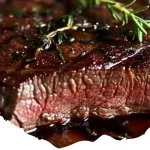
Gordon Ramsay Steak Marinade
- Author: recipstep
- Total Time: Plus at least 2 hours for marinating
- Yield: Marinade for 4 steaks
- Diet: Gluten Free
Description
Elevate your steak game with Gordon Ramsay’s signature steak marinade. This recipe combines robust flavors and simple ingredients to create a mouthwatering experience that’s sure to impress. Perfect for any cut of steak, this marinade promises tenderness and a burst of flavor with every bite.
Ingredients
– 12 oz (340 g) Steak (your choice of cut)
– 1/3 cup Balsamic Vinegar
– 2 tablespoons Soy Sauce
– 3 tablespoons Olive Oil, divided
– 2 cloves Garlic, minced
– 2 sprigs Rosemary, minced
– 2/3 cup Dark Brown Sugar
– 1/2 teaspoon Kosher Salt
– 1/2 teaspoon Ground Black Pepper
– 1/3 teaspoon Red Pepper
Instructions
1. In a bowl, combine the minced garlic, minced rosemary, balsamic vinegar, soy sauce, dark brown sugar, 2 tablespoons of olive oil, kosher salt, ground black pepper, and red pepper. Mix well to create the marinade.
2. Place the steak in a zip-lock bag and pour the marinade over it. Seal the bag and shake well to ensure the steak is coated evenly. Place the bag in the refrigerator and let the steak marinate for at least 6 hours, or overnight for even better flavor.
3. After marinating, remove the steak from the bag and pat it dry with a paper towel. Discard the marinade.
4. In a skillet, heat 1 tablespoon of olive oil over medium-high heat. Once hot, add the steak to the skillet and cook to your preferred level of doneness, about 5-7 minutes per side for medium-rare, depending on the thickness of the steak. Adjust cooking time accordingly for your desired level of doneness.
5. Once cooked, remove the steak from the skillet and let it rest for a few minutes before slicing.
6. Slice the steak against the grain into thin slices.
7. Serve the deliciously marinated steak hot and enjoy!
Notes:
– The preparation time does not include marinating time.
– Cooking time may vary depending on the thickness and cut of the steak.
– The calorie count may vary depending on the specific cut of steak used
Notes
- For the best flavor, marinate the steaks overnight.
- Discard any leftover marinade that has come into contact with raw meat.
- Adjust the amount of garlic and herbs based on personal preference.
- Prep Time: 10 minutes
- Cook Time: Depends on steak thickness and desired doneness
- Category: Main Course
- Method: Grilling or Pan Searing
- Cuisine: International
Nutrition
- Calories: 70 kcal
- Sugar: 1 g
- Sodium: 510 mg
- Fat: 6 g
- Saturated Fat: 1 g
- Carbohydrates: 3 g
- Protein: 1 g

